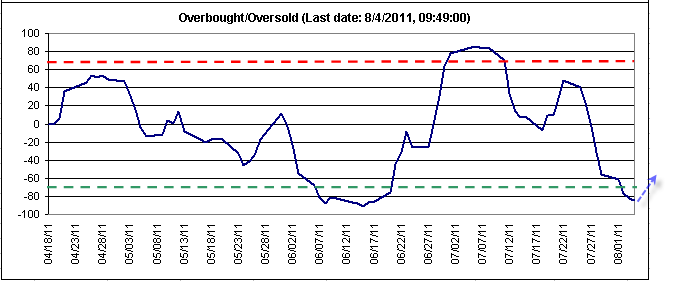Although the 20DMF's upper panel shows some accumulation, the lower panel is still deteriorating.
We need both the lower panel and the upper panel to move up for a 20DMF long signal to be issued.
Pascal

Although the 20DMF's upper panel shows some accumulation, the lower panel is still deteriorating.
We need both the lower panel and the upper panel to move up for a 20DMF long signal to be issued.
Pascal

Pascal-
I am new to this forum trying to understand the signals produced on the 20dMF charts. I never saw the answer to the question on why a short signal was not generated on the 20dMF when the pink line crossed the horizontal blue line of -0- around 7/27/01?
thanks
kim mcmorries
Kim,
Since early Pomo days, a short signal on the 20DMF must be confirmed by the average TEV of four inversed ETFs.
At the end of July, although the confirmation signal was very close, it never was issued.
You might refer to the IWM robot discussion of the past few days or on the discussion about this issue on the Multi Pivots forum
Pascal
Pascal,
In regards to this, I know you recently said you believe it would be better to focus on improving the Robot trading rules, as opposed to making changes in the 20DMF algo. I'm struggling with trying to understand why this would be so. If the IWM Robot is, in large part, driven by the directional signal of the 20DMF, and as we saw recently, an incorrect signal can lead the Robot down the wrong path resulting in numerous trades on the wrong side of the market, wouldn't it make more sense to focus on improving the 20DMF?
The 20DMF is much simpler than the robot and relatively easier to adapt. I only need to insert a new shorting rule.
This will be tested before the next shorting wave starts (before the signal reverses back above the 0 line).
Will this be satisfactory? Not really, because I am trading the robots and I would like these to be strong against a possible 20DMF error, without changing the robot rules themselves. Today, there are four levels in the robot:
buy, short, neutral buy, neutral short. I am studying the different signal strength in relation to the subsequent trade. For example, trades generated by a neutral buy signal are very different from trades generated by a buy signal or even by a neutral short signal. I will try to use these differences in behavior to adapt not the rules that are used to define the LT/ST edges, but the entry/exit/stop rules and money allocation depending on the type of LT/ST edge that we encounter.
This work requests both thinking and testing. The testing part is always long, because I have to test each of the four situations separately.
For example, we can imagine that we trade only neutral long signals. These are the signal that are neutral, but with a weak edge found to be long. Today's trading conditions are the same for all the signals: 1/3 RR entry, exit on a trailing stop. However, for this specific type of signal, shouldn't we use different sort of entry and exit strategies? If the edge is very weak, we could either decide to stay in cash or trade only at the strongest pivot levels and exit in a pivot target.
I believe that the robot will be improved after this analysis is completed.
In the mean time, as soon as the actual statistical extreme conditions are out of the way, we will re-engage the IWM robot, which is now dis-engaged (in cash) because of extreme market conditions it has not been programmed for.
It would be nice to re-engage an improved IWM robot, but if the analysis work is not complete at that time, we will re-engage with the actual IWM robot and upgrade it later on.
As of now, the best is not to ask further questions on the subject. Although responding to these questions is interesting, this eats up the time I have to do the analysis itself.
Pascal
Ok, fair enough. Thanks for the explanation.